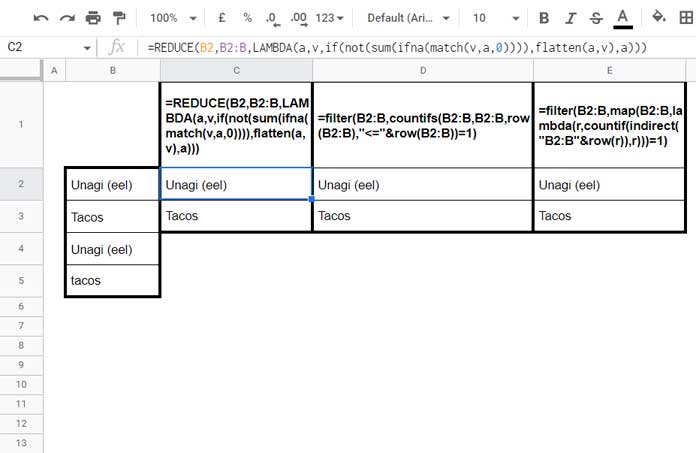The UNIQUE function is case-sensitive, but there are a few good options for case-insensitive unique in Google Sheets.
Usually, users use the functions PROPER, LOWER, or UPPER with UNIQUE for case-insensitive unique in Google Sheets.
It has one minor issue. It converts the returned output to proper, lower, or upper cases.
The syntax is as follows: =ArrayFormula(UNIQUE(PROPER(range)))
In this, you can replace ArrayFormula with INDEX or SORT and PROPER with LOWER or UPPER.
In the below table, I have shown the result of the above combinations by converting a few food & dishes names in the range B2:B5.
| Foods & Dishes | Proper | Lower | Upper |
| Unagi (eel) | Unagi (Eel) | unagi (eel) | UNAGI (EEL) |
| Tacos | Tacos | tacos | TACOS |
| Unagi (eel) | |||
| tacos |
Here is the case-insensitive formula in use in the second column.
=ArrayFormula(unique(proper(B2:B)))In the third and fourth columns, the proper got replaced by lower and upper.
Actually, the output should be “Unagi (eel)” and “Tacos,” the first occurrences of the case-insensitive unique values.
If you try =UNIQUE(B2:B5) in Excel, you will get that result because the UNIQUE function in Excel is case-insensitive.
How do we get the same effect in Google Sheets?
Case-Insensitive Unique Formula Options in Google Sheets
Here are my best three suggestions, and in them, the first two formulas use running count to return case-insensitive unique values in Google Sheets.
The third formula is quite interesting as it uses REDUCE function for case-insensitive unique in Google Sheets.
Why is it interesting?
The REDUCE is for reducing an array into a single value. But that single value can even be a reduced array containing multiple values.
You can learn that with this example.
Here are the formulas one by one.

Formula # 1 (D2):
=filter(B2:B,countifs(B2:B,B2:B,row(B2:B),"<="&row(B2:B))=1)The COUNTIFS part returns the running count of the foods and dishes in the range B2:B.
The role of the FILTER function here is to return the names of foods and dishes wherever the running count is equal to 1.
Formula # 2 (E2):
=filter(B2:B,map(B2:B,lambda(r,countif(indirect("B2:B"&row(r)),r)))=1)Here also, the logic is the same. The MAP, a Lambda Helper function, returns the running count, and the FILTER does its job as above.
Formula # 3 (C2):
=REDUCE(B2,B2:B,LAMBDA(a,v,if(not(sum(ifna(match(v,a,0)))),flatten(a,v),a)))Here things are different! Let me explain this REDUCE case-insensitive unique formula in detail below.
Formula Explanation
Syntax: REDUCE(initial_value, array_or_range, lambda)
The initial_value (in the accumulator) is the first cell value (B2) in the array_or_range (B2:B).
Lambda Syntax: LAMBDA(name1, name2, formula_expression)
name1 = a
name2 = v
In REDUCE, as you may know, the accumulator (a) is updated in each step.
The v resolves to the current value in array_or_range (B2:B), row by row.
Now the formula_expression part, which is essential in the case-insensitive unique.
The formula expression is like this. If v doesn’t match in a, flatten a and v, else return a.
The following table will give you a clear picture of how the REDUCE can return case-insensitive unique values in Google Sheets.
Initially, a and v are the same, which is the value in cell B2.
| After Processing | Matches or Not | a | v |
| B2 | B2 (v) matches in a so it returns a | Unagi (eel) | Unagi (eel) |
| B3 | B3 (v) doesn’t match in a so it returns flatten(a,v) | Unagi (eel) | Tacos |
| B4 | B4 (v) matches in a so it returns a | Unagi (eel) Tacos | Unagi (eel) |
| B5 | B5 (v) matches in a so it returns a | Unagi (eel) Tacos | tacos |
That’s all. Thanks for the stay. Enjoy!





















